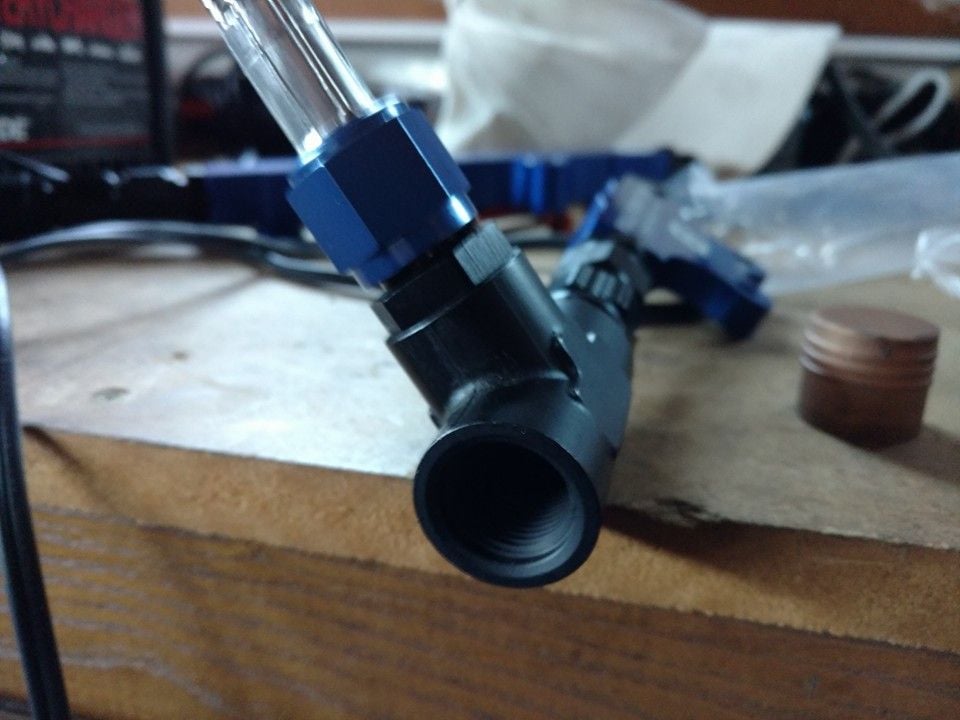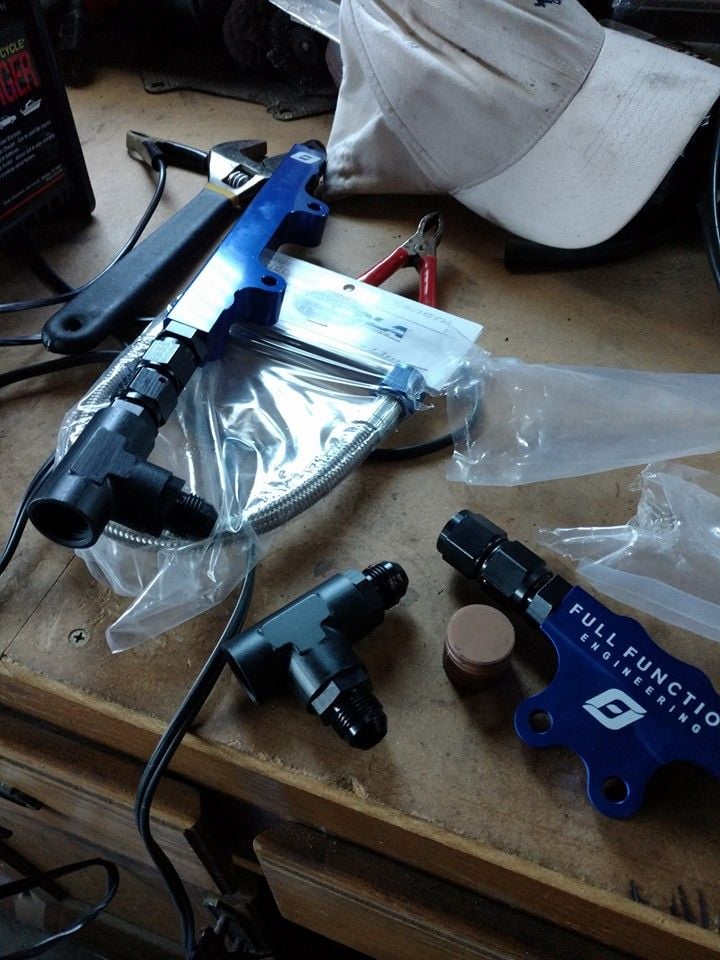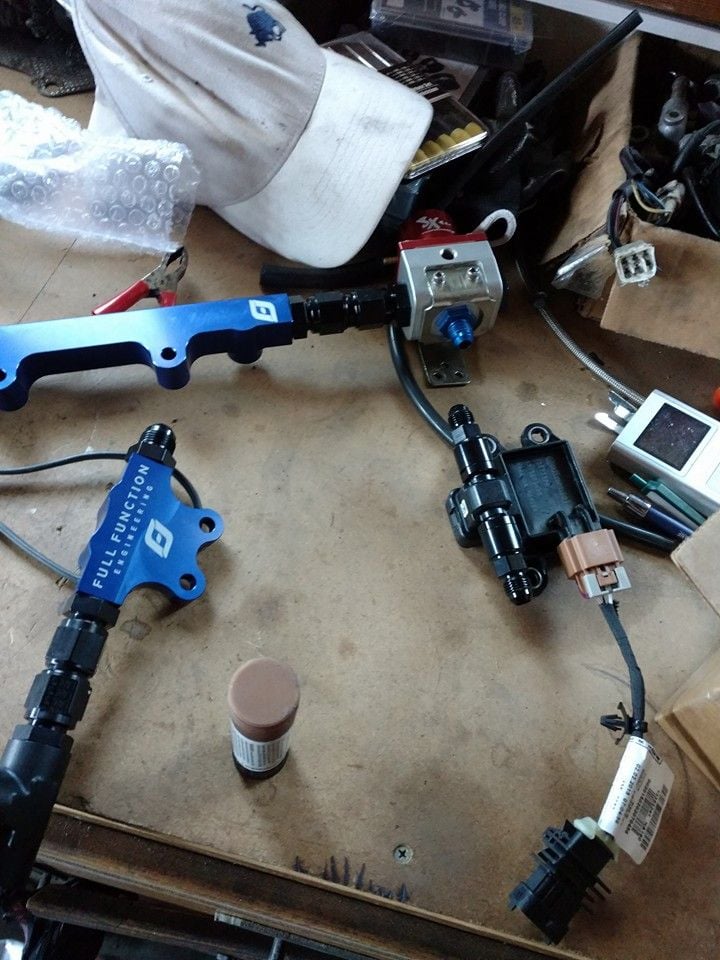Effect of higher fuel pressure with shorter spray duration.
#1
Effect of higher fuel pressure with shorter spray duration.
I am in the midst of planning a build and for a while now I’ve been pondering the idea of running small injectors and feeding them with high pressure for maximum atomization. I’m under the impression a higher base pressure will improve atomization, but at the same time I’ve also heard too much pressure can hinder it. If anyone has data on where the point of no further gain is I would love to see it.
Hypothetically speaking, let’s say I have a mechanical fuel pump and regulator capable of reliably maintaining a differential fuel pressure of 100 psi. Let’s say my horsepower goal is 450-475hp at 85% duty cycle.
According ID's data
ID1000 flow 1015cc/min @ 3 Bar (43.5 psi) x4 injectors = 4069cc/min
And @85% dubty cycle = roughly 500hp worth of fuel.
Running four ID1000 at standard base pressure would clearly meet my needs.
ID725 flow 715cc/min @ 3 Bar (43.5 psi) x4 injectors = 2860cc/min
And @85% dubty cycle = roughly 350hp worth of fuel.
Inadequate, However when pressure is increased the story changes.
ID725 flow aprox 1100cc/min @ 7 bar (101 psi) x4 injectors = 4400cc/min
And @ 85% dubty cycle = roughly 540hp worth of fuel.
As you can see when pressure is increased suddenly the ID725 can flow enough fuel to exceed my needs. Question is would it be worth running smaller injectors in attempt to increase atomization and consequently reduce the spray duration or run larger injectors which would spray for a longer duration with larger droplets?
Hypothetically speaking, let’s say I have a mechanical fuel pump and regulator capable of reliably maintaining a differential fuel pressure of 100 psi. Let’s say my horsepower goal is 450-475hp at 85% duty cycle.
According ID's data
ID1000 flow 1015cc/min @ 3 Bar (43.5 psi) x4 injectors = 4069cc/min
And @85% dubty cycle = roughly 500hp worth of fuel.
Running four ID1000 at standard base pressure would clearly meet my needs.
ID725 flow 715cc/min @ 3 Bar (43.5 psi) x4 injectors = 2860cc/min
And @85% dubty cycle = roughly 350hp worth of fuel.
Inadequate, However when pressure is increased the story changes.
ID725 flow aprox 1100cc/min @ 7 bar (101 psi) x4 injectors = 4400cc/min
And @ 85% dubty cycle = roughly 540hp worth of fuel.
As you can see when pressure is increased suddenly the ID725 can flow enough fuel to exceed my needs. Question is would it be worth running smaller injectors in attempt to increase atomization and consequently reduce the spray duration or run larger injectors which would spray for a longer duration with larger droplets?
#2
Moderator
iTrader: (3)
Join Date: Mar 2001
Location: https://www2.mazda.com/en/100th/
Posts: 30,802
Received 2,577 Likes
on
1,831 Posts
i want to try this too, i see a few advantages.
first, better atomization has to help, although how much is unknown.
second; a shorter, better timed, pulse should help the low rpm range when there is a lot of cycle time. i would expect it to run more smoothly, lower emissions, and possibly better fuel consumption, although i would suspect it to be a pretty small change
i do not see a downside, except you'd need to retune the whole fuel map
first, better atomization has to help, although how much is unknown.
second; a shorter, better timed, pulse should help the low rpm range when there is a lot of cycle time. i would expect it to run more smoothly, lower emissions, and possibly better fuel consumption, although i would suspect it to be a pretty small change
i do not see a downside, except you'd need to retune the whole fuel map
#4
The small problem with that sort of pressure increase is the injector has to over come that pressure to open, it would slow the opening time of the injector, I had a race car come into work with a crank no fire fault years ago, they had just fitted dry break fittings to the fuel lines and hadn't pushed the return line back in properly, with the pumps running it was seeing 120psi fuel pressure and this would hold the injectors shut, turn the pumps off and wait for the pressure to drop and it would fire up briefly. Im no expert but I think the highest pressure I've seen is around the 60psi mark, hope that helps!
#5
Injector dynamics lists the maximum differential pressures on their website as follows
ID725
Nominal Volumetric Flow Rate – 715cc/min @ 3.0 Bar (43.5 psi) Using Gasoline at 52 Degrees C (125 Degrees F)
Maximum Differential Fuel Pressure – 8.5 Bar (123.5 psi)
Fuel Compatibility – Compatible With All Known Fuels
Electrical Connector - USCAR
ID850
Nominal Flow Rate – 885cc/min @ 3.0 Bar (43.5 psi) Using Gasoline at 52 Degrees C (125 Degrees F)
Maximum Differential Fuel Pressure – 7.0 Bar (101.5 psi)
Fuel Compatibility – Compatible With All Known Fuels
Electrical Connector – USCAR
ID1000
Nominal Flow Rate - 1015cc/min @ 3.0 Bar (43.5 psi) Using Gasoline at 52 Degrees C (125 Degrees F)
Maximum Differential Fuel Pressure - 7.0 Bar (101.5 psi)
Fuel Compatibility - Compatible With All Known Fuels
Electrical Connector - USCAR
interestingly enough the ID725 can handle the highest pressures of the bunch. I would actually consider running 120 psi or so if I could find a regulator that could regulate at such pressures. Apparently the Aeromotive regulator designed for and typically used with mechanical fuel pumps handles up to only (ha) 100psi.
Aeromotive | 13113 - Belt/Hex Drive EFI Regulator
ID725
Nominal Volumetric Flow Rate – 715cc/min @ 3.0 Bar (43.5 psi) Using Gasoline at 52 Degrees C (125 Degrees F)
Maximum Differential Fuel Pressure – 8.5 Bar (123.5 psi)
Fuel Compatibility – Compatible With All Known Fuels
Electrical Connector - USCAR
ID850
Nominal Flow Rate – 885cc/min @ 3.0 Bar (43.5 psi) Using Gasoline at 52 Degrees C (125 Degrees F)
Maximum Differential Fuel Pressure – 7.0 Bar (101.5 psi)
Fuel Compatibility – Compatible With All Known Fuels
Electrical Connector – USCAR
ID1000
Nominal Flow Rate - 1015cc/min @ 3.0 Bar (43.5 psi) Using Gasoline at 52 Degrees C (125 Degrees F)
Maximum Differential Fuel Pressure - 7.0 Bar (101.5 psi)
Fuel Compatibility - Compatible With All Known Fuels
Electrical Connector - USCAR
interestingly enough the ID725 can handle the highest pressures of the bunch. I would actually consider running 120 psi or so if I could find a regulator that could regulate at such pressures. Apparently the Aeromotive regulator designed for and typically used with mechanical fuel pumps handles up to only (ha) 100psi.
Aeromotive | 13113 - Belt/Hex Drive EFI Regulator
#6
The issue comes in with the pump. You have to have a pump that can handle that kind of pressure, long term, and without issue. The pump has to fight/maintain 100+psi at all times, that is 2.5 times the "normal" amount of "back feed" pressure the pump would see. Now, this also depends on your engine's fuel requirements etc but it IS a big pump concern in regards to failure. I recommend using a multi pump setup with a mechanical pump being the engine/injector feeder.
But to add to this thread: Turbo F1 in the 80's regularly used fuel pressures in the 120psi range...
There is a good reason for this!
-J
But to add to this thread: Turbo F1 in the 80's regularly used fuel pressures in the 120psi range...
There is a good reason for this!
-J
#7
Moderator
iTrader: (3)
Join Date: Mar 2001
Location: https://www2.mazda.com/en/100th/
Posts: 30,802
Received 2,577 Likes
on
1,831 Posts
The issue comes in with the pump. You have to have a pump that can handle that kind of pressure, long term, and without issue. The pump has to fight/maintain 100+psi at all times, that is 2.5 times the "normal" amount of "back feed" pressure the pump would see. Now, this also depends on your engine's fuel requirements etc but it IS a big pump concern in regards to failure. I recommend using a multi pump setup with a mechanical pump being the engine/injector feeder.
But to add to this thread: Turbo F1 in the 80's regularly used fuel pressures in the 120psi range...
There is a good reason for this!
-J
But to add to this thread: Turbo F1 in the 80's regularly used fuel pressures in the 120psi range...
There is a good reason for this!
-J
Trending Topics
#11
Old [Sch|F]ool
Seriously, look into the Bosch pumps. They were designed around K-Jet injection which has a design pressure in the 100psi range. They last essentially forever.
#12
Full Member
The small problem with that sort of pressure increase is the injector has to over come that pressure to open, it would slow the opening time of the injector, I had a race car come into work with a crank no fire fault years ago, they had just fitted dry break fittings to the fuel lines and hadn't pushed the return line back in properly, with the pumps running it was seeing 120psi fuel pressure and this would hold the injectors shut, turn the pumps off and wait for the pressure to drop and it would fire up briefly. Im no expert but I think the highest pressure I've seen is around the 60psi mark, hope that helps!
Can the return spring close the injector orifice? Sure. But how is the pulse width that is set in the ECU fuel table going to be tightly adhered to and provide accurate fuelling if the time it takes for the spring to overcome the extreme fuel pressure once the electromagnetic coil is de-energized adds to the total time that the injector is "open"?
This is exacerbated when the RPM is mid-high, and the injector has to open and close more rapidly.
The best thing you can do for atomization of fuel is to buy injectors that have great atomization from the get-go, and run them at the intended fuel pressure. It will cost you less in the long run. Pumps that claim 100-120psi tend to degrade over time, and fuel pressure starts to come down over a year or so of use. The diaphragms get weak, and the rotors start to wear down and they never operate as good as they did in the first year of use.
You can also run Bosch 044's in series, or even any pump in series really... but it could end up being costly when you start experimenting with which ones like being pressurized on the inlet to elevated pressures not seen in normal surge tank fueling systems.
Honestly... buy well tuned injectors and a decent fuel pump. Running fuel pressures at 120psi is the last thing I would do to achieve atomization in any application considering the options that will achieve the same thing with less strain on every single component in the fuel system.
#13
Banned. I got OWNED!!!




For a lift pump inside my internal surge tank, I'm running a Walbro 416 e85 (0 psi, it's a lift pump).
For my pressure pump, I'll be using an Injector Dynamics rotary vane unit.
Now, considering I plan on running 17-22psi at maximum pressures on e85 and I'm using a 1:1 rising rate fuel pressure regulator, my base pressure shouldn't be anything higher than 70psi. The ID pump would be generating 92psi of positive pressure at my fuel rails to maintain that boost pressure. My setup will be 4x ID1700s on e85 with a tiny little 54 trim turbo and p-trim turbine wheel. 400whp max.
What we need to worry about when raising pressures is HEAT, especially with e85. PWM controlled fuel pumps (or using a Hobb's Switch at a certain boost level for a secondary pump/jump in pump speed) is the way to go.
With all this pressure, I plan on running 2x Radium Engineering Fuel Dampers in -8 ORB configuration. If you aren't running a damper on your setup, I highly suggest you log fuel pressure and see what it's doing. Ludwig did an awesome experiment on this forum in regards to that.
Looking forward to see what you guys come up with, but I think I have my setup dialed. We'll see...
Last edited by RGHTBrainDesign; 03-16-16 at 10:18 PM.
#14
Full Member
Sounds like an interesting setup. Do you have a link to the damper testing Ludwig did? I'd like to read up on it.
Might I suggest the 8 bar version of the Bosch 044? It's not the typical 5 bar version, and if your injector type can run well under 8 bar pressure then it is a good option.
Might I suggest the 8 bar version of the Bosch 044? It's not the typical 5 bar version, and if your injector type can run well under 8 bar pressure then it is a good option.
#15
So, we call it the '044 because its Bosch part# is "0 580 254 044".
Looks like Bosch Motorsports calls it the "Fuel Pump FP200" (for greater than 200 liters/hour- nominal flow and I have heard they test with more viscous fluid than gas).
Looks like the 8 bar version is part # "B 261 205 413-01"
Looks like Bosch Motorsports calls both pumps the "Fuel Pump FP200".
This is new to me too, I just got the regular '044.
Bosch Motorsports PDF
http://www.bosch-motorsport.com/medi...6426379pdf.pdf
'044 rated 260L/hr at 5 bar and 14V
'413-01 rated 220L/hr at 8 bar and 14V
If that doesn't sound impressive its because we are used to other manufacturers who rate their flow at 0 bar... If you find charts of their pumps at 5 bar and 8bar you will see the old Bosch Motorsports pumps still impress!
Looks like Bosch Motorsports calls it the "Fuel Pump FP200" (for greater than 200 liters/hour- nominal flow and I have heard they test with more viscous fluid than gas).
Looks like the 8 bar version is part # "B 261 205 413-01"
Looks like Bosch Motorsports calls both pumps the "Fuel Pump FP200".
This is new to me too, I just got the regular '044.
Bosch Motorsports PDF
http://www.bosch-motorsport.com/medi...6426379pdf.pdf
'044 rated 260L/hr at 5 bar and 14V
'413-01 rated 220L/hr at 8 bar and 14V
If that doesn't sound impressive its because we are used to other manufacturers who rate their flow at 0 bar... If you find charts of their pumps at 5 bar and 8bar you will see the old Bosch Motorsports pumps still impress!
Last edited by BLUE TII; 03-17-16 at 12:18 PM.
#16
Full Member
They may not look fancy, but they are a cut above the rest in terms of sound level, amp draw, pressure level, and flow at elevated pressures.
There are other pumps that out-shine the 044 and 044 high-bar version, but realistically, the Bosch performs more than reasonably well in all categories (aside from the looks department), whereas others are only good in half the categories, and perform poorly in others.
size
sound
installation
amp draw
flow + pressure
looks
sound
sound
sound
and sound
all things the 044 series are pretty good at.
I can't stand fuel pumps that sound like B16's to feed engines that will only make use of 1/3rd of the total output. Headroom is good, but obnoxious is obnoxious.
There are other pumps that out-shine the 044 and 044 high-bar version, but realistically, the Bosch performs more than reasonably well in all categories (aside from the looks department), whereas others are only good in half the categories, and perform poorly in others.
size
sound
installation
amp draw
flow + pressure
looks
sound
sound
sound
and sound
all things the 044 series are pretty good at.
I can't stand fuel pumps that sound like B16's to feed engines that will only make use of 1/3rd of the total output. Headroom is good, but obnoxious is obnoxious.
#17
Yeah. Bosch Motorsports pumps have been used on just about every Japanese time attack car ever.
My current dream fuel set-up is intank Denso Supra pump to an Integrated Engineering surge pot with dual 8 bar FP200s driven by ECU as return-less and each using a stock fuel rail (1x supply, 1x return).
Simple, clean, reliable, quiet and a flood of fuel.
My current dream fuel set-up is intank Denso Supra pump to an Integrated Engineering surge pot with dual 8 bar FP200s driven by ECU as return-less and each using a stock fuel rail (1x supply, 1x return).
Simple, clean, reliable, quiet and a flood of fuel.
#18
I don't even think you'd need a swirl pot with that setup if you had downstream regulators. Or are you talking about running them off a fuel pump driver to vary the duty cycle and pressure?
Not quite the same, but I run my fuel setup dead headed to the rail with a regulator by the tank and have not had any fuel starvation issues. You just have to have enough pump headroom to maintain consistent fuel pressure up stream.
Not quite the same, but I run my fuel setup dead headed to the rail with a regulator by the tank and have not had any fuel starvation issues. You just have to have enough pump headroom to maintain consistent fuel pressure up stream.
Thread
Thread Starter
Forum
Replies
Last Post
trickster
2nd Generation Specific (1986-1992)
25
07-01-23 04:40 PM



